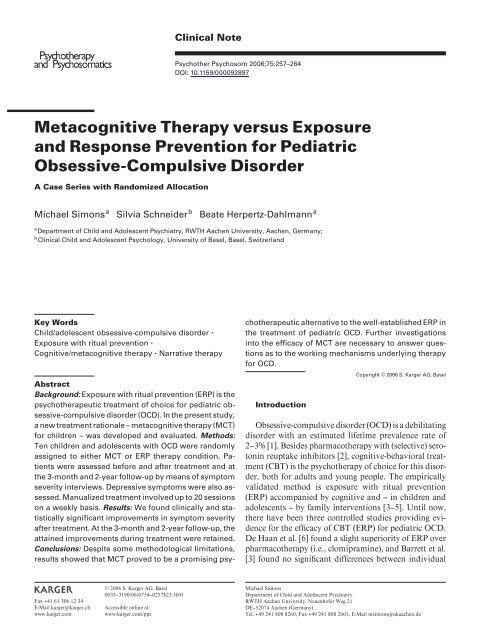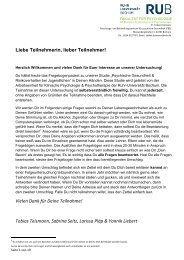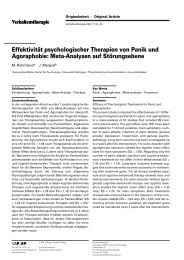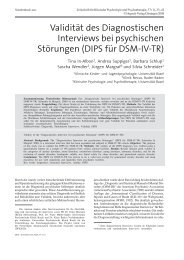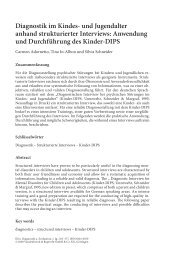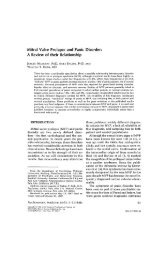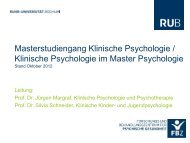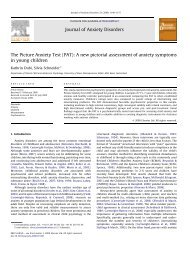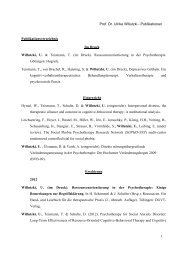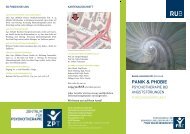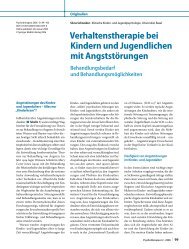Metacognitive Therapy versus Exposure and Response Prevention ...
Metacognitive Therapy versus Exposure and Response Prevention ...
Metacognitive Therapy versus Exposure and Response Prevention ...
Create successful ePaper yourself
Turn your PDF publications into a flip-book with our unique Google optimized e-Paper software.
Clinical Note<br />
Psychother Psychosom 2006;75:257–264<br />
DOI: 10.1159/000092897<br />
<strong>Metacognitive</strong> <strong>Therapy</strong> <strong>versus</strong> <strong>Exposure</strong><br />
<strong>and</strong> <strong>Response</strong> <strong>Prevention</strong> for Pediatric<br />
Obsessive-Compulsive Disorder<br />
A Case Series with R<strong>and</strong>omized Allocation<br />
a b a<br />
Michael Simons Silvia Schneider Beate Herpertz-Dahlmann<br />
a<br />
Department of Child <strong>and</strong> Adolescent Psychiatry, RWTH Aachen University, Aachen , Germany;<br />
b<br />
Clinical Child <strong>and</strong> Adolescent Psychology, University of Basel, Basel , Switzerl<strong>and</strong><br />
Key Words<br />
Child/adolescent obsessive-compulsive disorder <br />
<strong>Exposure</strong> with ritual prevention <br />
Cognitive/metacognitive therapy Narrative therapy<br />
Abstract<br />
Background: <strong>Exposure</strong> with ritual prevention (ERP) is the<br />
psychotherapeutic treatment of choice for pediatric obsessive-compulsive<br />
disorder (OCD). In the present study,<br />
a new treatment rationale – metacognitive therapy (MCT)<br />
for children – was developed <strong>and</strong> evaluated. Methods:<br />
Ten children <strong>and</strong> adolescents with OCD were r<strong>and</strong>omly<br />
assigned to either MCT or ERP therapy condition. Patients<br />
were assessed before <strong>and</strong> after treatment <strong>and</strong> at<br />
the 3-month <strong>and</strong> 2-year follow-up by means of symptom<br />
severity interviews. Depressive symptoms were also assessed.<br />
Manualized treatment involved up to 20 sessions<br />
on a weekly basis. Results: We found clinically <strong>and</strong> statistically<br />
significant improvements in symptom severity<br />
after treatment. At the 3-month <strong>and</strong> 2-year follow-up, the<br />
attained improvements during treatment were retained.<br />
Conclusions: Despite some methodological limitations,<br />
results showed that MCT proved to be a promising psy-<br />
chotherapeutic alternative to the well-established ERP in<br />
the treatment of pediatric OCD. Further investigations<br />
into the efficacy of MCT are necessary to answer questions<br />
as to the working mechanisms underlying therapy<br />
for OCD.<br />
Introduction<br />
Copyright © 2006 S. Karger AG, Basel<br />
Obsessive-compulsive disorder (OCD) is a debilitating<br />
disorder with an estimated lifetime prevalence rate of<br />
2–3% [1] . Besides pharmacotherapy with (selective) serotonin<br />
reuptake inhibitors [2] , cognitive-behavioral treatment<br />
(CBT) is the psychotherapy of choice for this disorder,<br />
both for adults <strong>and</strong> young people. The empirically<br />
validated method is exposure with ritual prevention<br />
(ERP) accompanied by cognitive <strong>and</strong> – in children <strong>and</strong><br />
adolescents – by family interventions [3–5] . Until now,<br />
there have been three controlled studies providing evidence<br />
for the efficacy of CBT (ERP) for pediatric OCD.<br />
De Haan et al. [6] found a slight superiority of ERP over<br />
pharmacotherapy (i.e., clomipramine), <strong>and</strong> Barrett et al.<br />
[3] found no significant differences between individual<br />
Fax +41 61 306 12 34<br />
E-Mail karger@karger.ch<br />
www.karger.com<br />
© 2006 S. Karger AG, Basel<br />
0033–3190/06/0754–0257$23.50/0<br />
Accessible online at:<br />
www.karger.com/pps<br />
Michael Simons<br />
Department of Child <strong>and</strong> Adolescent Psychiatry<br />
RWTH Aachen University, Neuenhofer Weg 21<br />
DE–52074 Aachen (Germany)<br />
Tel. +49 241 808 8260, Fax +49 241 808 2601, E-Mail msimons@ukaachen.de
<strong>and</strong> group cognitive-behavioral family treatment regarding<br />
efficacy <strong>and</strong> durability of treatment gains. In a very<br />
recent study, the combination of CBT <strong>and</strong> pharmacotherapy<br />
(i.e., sertraline) proved to be superior to CBT<br />
alone <strong>and</strong> to sertraline alone [5] . The effectiveness of ERP<br />
is limited by high rates of treatment rejection <strong>and</strong> dropouts<br />
[7] . This strongly indicates that there is a need for a<br />
psychotherapeutic alternative to ERP. Furthermore, the<br />
efficacy of ERP cannot be attributed solely to habituation<br />
[8] . In some cases, symptom reduction could be better<br />
explained by cognitive changes or by changes in self-efficacy.<br />
This makes cognitive therapy a promising alternative<br />
or additional treatment strategy [9] .<br />
New cognitive <strong>and</strong> metacognitive OCD models [10–<br />
12] led to new intervention techniques – at least in the<br />
treatment of adult patients. Until now, there have been<br />
only a few case studies [13, 14] <strong>and</strong> a case series [15] applying<br />
these new interventions to children <strong>and</strong> adolescents.<br />
OCD – A <strong>Metacognitive</strong> Model<br />
According to the cognitive model of Salkovskis <strong>and</strong><br />
McGuire [16] <strong>and</strong> Wells’ metacognitive model [11, 12] ,<br />
obsessional thoughts develop from normal intrusive<br />
thoughts that are interpreted <strong>and</strong> dealt with in special<br />
ways. OCD patients tend to confuse these thoughts with<br />
real actions, or events, or intentions (metacognitive misinterpretation)<br />
[17, 18] . They tend to make use of several<br />
dysfunctional metacognitive processes, such as increased<br />
cognitive self-consciousness (‘too much thinking about<br />
thinking’) [19, 20] , thought suppression, <strong>and</strong> selective attention<br />
to further intrusive thoughts. Moreover, they often<br />
are not sure when to stop the ritual, <strong>and</strong> make use of dysfunctional<br />
stop signals like ‘emotional reasoning’ (e.g. they<br />
have to repeat the ritual until they ‘feel’ safe or clean).<br />
These various metacognitive appraisals (e.g. thoughtaction<br />
fusion) <strong>and</strong> metacognitive processes (thought control<br />
strategies, selective attention) can be understood as<br />
dysfunctional solutions which lead to further exacerbations<br />
of the vicious cycle of OCD. Recently, Mather <strong>and</strong><br />
Cartwright-Hatton [21] have found these metacognitions<br />
to be good predictors of obsessive-compulsive symptoms<br />
in adolescents <strong>and</strong> proposed a more metacognitively enhanced<br />
therapy.<br />
<strong>Metacognitive</strong> <strong>Therapy</strong><br />
<strong>Metacognitive</strong> therapy (MCT) aims to change dysfunctional<br />
metacognitive appraisals <strong>and</strong> strategies. The<br />
new term ‘metacognitive therapy’ [22, 23] marks the major<br />
differences to st<strong>and</strong>ard cognitive therapy. In the latter,<br />
the contents of thoughts are discussed <strong>and</strong> examined with<br />
regard to their truthfulness <strong>and</strong> probability [24] . In MCT,<br />
the focus does not lie on the content of obsessions <strong>and</strong><br />
intrusive thoughts, but on the appraisal <strong>and</strong> the management<br />
of these thoughts. These thoughts are normalized<br />
by simply accepting them. Furthermore, probability ratings<br />
(e.g. ‘How probable do you think it is that you could<br />
contaminate your parents?’) are seldom useful in OCD<br />
patients. Although they often know that the risk is very<br />
low, they are not sure that they can take it.<br />
In psychoeducation, the patient’s specific problemmaintaining<br />
metacognitive appraisals <strong>and</strong> strategies are<br />
to be discovered, while the therapist emphasizes the normality<br />
of these processes [10] . Socratic dialogue, thought<br />
control experiments, <strong>and</strong> behavioral experiments aim to<br />
change these metacognitive strategies <strong>and</strong> appraisals.<br />
Cottraux et al. [25] conducted one of the few studies<br />
that compare cognitive therapy <strong>and</strong> behavior therapy in<br />
adult OCD. In the present study, the efficacy of MCT for<br />
children <strong>and</strong> adolescents with OCD was investigated. According<br />
to the Task Force criteria of the American Psychological<br />
Association for the identification of empirically<br />
supported treatments [26] , MCT was tested against<br />
the already established ERP treatment. Both treatment<br />
strategies were protocol driven according to two different<br />
manuals written by the first author [22] . It was hypothesized<br />
that both treatment strategies would be effective at<br />
post-treatment <strong>and</strong> would have lasting effects after 3<br />
months <strong>and</strong> after 2 years.<br />
Method<br />
Participants <strong>and</strong> Procedure<br />
Eleven children <strong>and</strong> adolescents (7 males <strong>and</strong> 4 females) with<br />
OCD, aged 8–17 years, participated in the study. All were treated<br />
in a child <strong>and</strong> adolescent psychiatric outpatient setting <strong>and</strong> were<br />
assigned either to narrative ERP or to MCT by simple r<strong>and</strong>omization.<br />
One (male) patient dropped out of MCT, as it dem<strong>and</strong>ed too<br />
much self-reflection on his part. He was successfully treated with<br />
ERP but excluded from further calculations. None of the remaining<br />
10 patients (n = 5 in each group) received pharmacotherapy against<br />
OCD.<br />
All participants were diagnosed according to the DSM-IV/ICD-<br />
10 diagnosis of OCD based on the German structured clinical interview<br />
‘Kinder-DIPS’ [27] with the patients <strong>and</strong> their families <strong>and</strong><br />
on the well-established clinical interview Children’s Yale-Brown<br />
Obsessive Compulsive Scale (CY-BOCS). Patients were excluded<br />
if they had a diagnosis of mental retardation, autism, psychosis,<br />
<strong>and</strong> current treatment using pharmacotherapy for OCD.<br />
Five patients had one or more comorbid diagnoses, including<br />
agoraphobia (n = 2), Tourette’s syndrome (n = 1), chronic tic disorder<br />
(n = 2), <strong>and</strong> attention deficit hyperactivity disorder (ADHD)<br />
(n = 2).<br />
258<br />
Psychother Psychosom 2006;75:257–264<br />
Simons /Schneider /Herpertz-Dahlmann
Table 1. Details of obsessive-compulsive psychopathology <strong>and</strong> metacognitive therapy suggestions for the five MCT patients<br />
No. Obsession Compulsion Dysfunctional<br />
metacognitive appraisal/<br />
strategy<br />
<strong>Metacognitive</strong> intervention<br />
ERP?<br />
6 Intrusion: thinking bad<br />
things during activities<br />
of daily life<br />
Repeating the activity<br />
when thinking good<br />
things<br />
Thought suppression<br />
Try different ways to h<strong>and</strong>le thoughts<br />
(suppressing, evoking, accepting) <strong>and</strong><br />
count the number of intrusions<br />
–<br />
7 Religious intrusions<br />
(voices) about death,<br />
dying, magical numbers<br />
(e.g., ‘14’)<br />
Repeatedly telling<br />
herself that she wants<br />
to live<br />
Thought suppression<br />
Thought-intention fusion<br />
(‘thinking about dying<br />
means, I want to die’)<br />
Thought-event fusion<br />
(‘if I think I die, I will die’)<br />
Thought suppression experiment<br />
Thought experiments:<br />
– Try to think of something that you<br />
don’t want to happen!<br />
– Try hard to fall asleep!<br />
– Try to win the lottery just by<br />
mental power!<br />
–<br />
8 Fear of contamination<br />
(a contaminating wart<br />
at one foot)<br />
H<strong>and</strong> washing until<br />
they smell clean;<br />
showering;<br />
not touching the wart;<br />
needing reassurance<br />
that she is not<br />
contaminated<br />
Dysfunctional stop signal<br />
(smell)<br />
Thought-fact fusion<br />
(‘thinking I am<br />
contaminated means I<br />
really am’)<br />
Behavioral experiment: Use unflavoured<br />
soap – how long will you wash?<br />
Thought-fact defusion: Try to turn<br />
the thought of an elephant into a real<br />
elephant<br />
1 session ERP as<br />
behavioral experiment<br />
(Touch the wart!) –<br />
Not successful:<br />
she didn’t habituate<br />
<strong>and</strong> prematurely<br />
broke off<br />
9 Intrusive thoughts about<br />
orientation in time <strong>and</strong><br />
space (Where am I?<br />
Which month is now?);<br />
fear of dissociation<br />
Thought control;<br />
trying to think more<br />
pleasant thoughts;<br />
reassuring himself<br />
where he is<br />
Thought suppression<br />
Selective attention towards<br />
the potential dissociative<br />
sensations<br />
Thought-event fusion<br />
(‘thinking this thought<br />
increases the risk that it<br />
comes true’)<br />
Thought suppression experiments<br />
Selective attention experiment<br />
Thought-event defusion: Try to win<br />
the lottery just by mental power!<br />
–<br />
10 Bad comm<strong>and</strong>ing<br />
thoughts;<br />
blasphemous thoughts;<br />
‘just right’ thoughts<br />
Touching <strong>and</strong> licking<br />
the floor, the<br />
furniture, etc.<br />
Thought suppression<br />
Thought-comm<strong>and</strong>ment<br />
fusion (‘if I think …,<br />
I have to do it’)<br />
Try different ways to h<strong>and</strong>le thoughts<br />
(suppressing, evoking, accepting) <strong>and</strong><br />
count the number of intrusions<br />
Thought-imperative defusion: you<br />
cannot do everything that you think of<br />
<strong>Metacognitive</strong> reframing (you could not<br />
suffer from these thoughts unless God is<br />
very important to you)<br />
–<br />
ERP = <strong>Exposure</strong> with ritual prevention.<br />
Measures<br />
The primary outcome was a change in OCD symptom severity,<br />
measured with the CY-BOCS. The CY-BOCS is a clinician-rated<br />
scale with two subscales (obsessions <strong>and</strong> compulsions). In each subscale,<br />
frequency, interference, distress, resistance (to obsessions/<br />
compulsions), <strong>and</strong> control are rated. The total score ranges from 0<br />
to 40. Scahill et al. [28] found good reliability <strong>and</strong> validity for the<br />
CY-BOCS. A recent study [29] found the two resistance items to<br />
be unreliable. This is in accordance with the metacognitive theory<br />
claiming that resistance to obsessions maintains obsessive-compulsive<br />
symptoms.<br />
The second outcome was a change in severity of depressive<br />
symptoms (self-rating), assessed using the German version of the<br />
Children’s Depression Inventory (CDI) [30] . The authors of the<br />
German version [31] report good reliability <strong>and</strong> validity. The 26<br />
items are scored on a 3-point scale. In the present study, the st<strong>and</strong>ardized<br />
T scores were used.<br />
All instruments were administered by the therapists at pretreatment,<br />
post-treatment, 3 months <strong>and</strong> 2 years after the completion<br />
of the therapy. At the 2-year follow-up, the clinical status regarding<br />
OCD was assessed using a structured psychiatric interview for the<br />
parents <strong>and</strong> the child (Kinder-DIPS) [27] . At the time of the last<br />
assessment, all interviews were performed by two experienced child<br />
<strong>and</strong> adolescent psychiatrists who were blinded to the patient’s treatment<br />
condition.<br />
Treatment<br />
All patients received up to 20 treatment sessions on a weekly<br />
basis provided mainly by the first author. Treatment was finished<br />
before the twentieth sessions if according to the estimation of both<br />
therapist <strong>and</strong> patient treatment goals were already met before. Parents<br />
were generally included in the therapy sessions except in cases,<br />
where the (older) adolescents did not permit it. There were no parent<br />
sessions without the patients.<br />
<strong>Metacognitive</strong> <strong>Therapy</strong> for Pediatric OCD Psychother Psychosom 2006;75:257–264 259
Table 2. Demographic <strong>and</strong> clinical<br />
characters of the two treatment groups<br />
Sample ERP MCT U p (2-tailed) 1<br />
Sex: m/f 4/1 2/3<br />
Age, years: Md, M, SD 14.08<br />
13.39<br />
3.06<br />
IQ score: Md, M, SD 90.00<br />
99.40<br />
25.06<br />
Duration, months: Md, M, SD 3.00<br />
9.80<br />
14.68<br />
CY-BOCS: Md, M, SD<br />
Range: 0–40<br />
CDI: Md, M, SD<br />
T score<br />
20.00<br />
17.00<br />
6.28<br />
50.00<br />
47.80<br />
9.68<br />
15.33<br />
14.53<br />
3.09<br />
106.00<br />
105.50<br />
9.88<br />
5.00<br />
5.60<br />
4.15<br />
26.00<br />
27.00<br />
5.87<br />
53.00<br />
51.20<br />
5.89<br />
8.0 0.347<br />
8.0 0.624<br />
12.5 1.000<br />
2.00 0.032*<br />
9.5 0.528<br />
1<br />
Mann-Whitney U-Test.<br />
Alpha level 0.05. Md = median; M = mean; SD = st<strong>and</strong>ard deviation; ERP = exposure<br />
with ritual prevention; MCT = metacognitive therapy; CY-BOCS = Children’s Yale-Brown<br />
Obsessive Scale; CDI = Child Depression Inventory (German version).<br />
The ERP treatment was similar to the published manual by<br />
March <strong>and</strong> Mulle [32] in combining ERP with narrative therapy.<br />
In contrast to this manual, however, no anxiety management techniques<br />
(such as relaxation training) were applied. In cases where<br />
the motivation for ERP began to decrease, home-based contingency<br />
management was added.<br />
MCT was based on techniques described by Salkovskis [10] <strong>and</strong><br />
Wells [11, 12] , adapted by the first author for children <strong>and</strong> adolescents.<br />
They were grossly comparable with already published cognitive<br />
interventions for adolescents with OCD [13–15] . The main<br />
differences between the two manuals were the interpretation of obsessions<br />
<strong>and</strong> the presumed working mechanism: in ERP, obsessions<br />
were conceptualized as meaningless <strong>and</strong> metaphorically described<br />
as ‘brain hiccups’ [32] . <strong>Therapy</strong> was explained to work by habituation.<br />
In MCT, obsessions were conceptualized as revealing the<br />
personal values <strong>and</strong> the deepest fears of the patient. <strong>Therapy</strong> aimed<br />
at challenging metacognitive appraisals (metacognitive restructuring)<br />
<strong>and</strong> changing metacognitive strategies (e.g. from suppressing<br />
thoughts to permitting/accepting them). Following Wells [12] , in<br />
this metacognitive framework ERP could be utilized as behavioral<br />
experiment intended to challenge dysfunctional metacognitions,<br />
but not in an intensive, repeated, or habituation-oriented manner.<br />
Accordingly, MCT patients were not encouraged to do ERP as<br />
homework. Details of the 5 MCT patients <strong>and</strong> their treatment can<br />
be seen in table 1 .<br />
Statistical Analysis<br />
Because of the small sample size only nonparametric tests were<br />
used. To examine the comparability of the two treatment groups,<br />
age, duration of complaints, IQ test scores, <strong>and</strong> the scores of the<br />
CY-BOCS <strong>and</strong> CDI before treatment were compared using the<br />
Mann-Whitney U test. The CY-BOCS total score as the primary<br />
outcome measure <strong>and</strong> the CDI T score were compared at pretreatment,<br />
post-treatment, <strong>and</strong> follow-up by calculating the nonparametric<br />
Wilcoxon paired rank sum test for every single treatment<br />
group. Using the Statistical Package for Social Sciences for Windows<br />
(SPSS) version 11.0, all hypotheses were examined at an alpha<br />
level of 0.05. Furthermore, the percentage of improvement <strong>and</strong> the<br />
effect sizes were evaluated using Cohen’s d [33] . Due to the small<br />
sample size, the effect sizes were corrected as recommended by<br />
Hedges <strong>and</strong> Olkin [34] .<br />
Results<br />
Comparability of the Treatment Groups<br />
Both treatment groups were comparable regarding<br />
their age, duration of complaints, IQ test scores, <strong>and</strong> depression<br />
scores ( table 2 ). The patients in the MCT condition<br />
had significantly higher CY-BOCS scores before<br />
treatment.<br />
Treatment Effects<br />
All patients showed a significant decrease in OCD<br />
symptom severity from pre- to post-treatment assess-<br />
260<br />
Psychother Psychosom 2006;75:257–264<br />
Simons /Schneider /Herpertz-Dahlmann
Fig. 1. CY-BOCS total scores for each patient<br />
treated with exposure <strong>and</strong> response<br />
prevention at pre- <strong>and</strong> post-treatment <strong>and</strong><br />
at follow-up 3 months <strong>and</strong> 2 years after<br />
treatment; range 0–40.<br />
Fig. 2. CY-BOCS total scores for each patient<br />
treated with metacognitive therapy at<br />
pre- <strong>and</strong> post-treatment <strong>and</strong> at follow-up 3<br />
months <strong>and</strong> 2 years after treatment; range<br />
0–40.<br />
ments ( fig. 1, 2 ). In the ERP condition, the CY-BOCS<br />
total scores decreased from 20 to 1 (z = –2.032, p = 0.042).<br />
In the MCT condition, the CY-BOCS total scores decreased<br />
from 26 to 6 (z = –2.032, p = 0.042).<br />
In both groups, depression scores tended to decrease<br />
from pre- to post-treatment assessments, but the differences<br />
were not statistically significant. CDI T scores decreased<br />
from 50 to 38 (z = –1.512, p = 0.131) in ERP <strong>and</strong><br />
from 53 to 41 (z = –1.461, p = 0.144) in the MCT condition.<br />
However, the scores were already in the average<br />
range before treatment.<br />
The average treatment duration was 13 sessions for<br />
ERP (mean = 13.0; SD = 6.04) <strong>and</strong> 9 sessions for MCT<br />
(mean = 10.2; SD = 3.3). There was no significant difference<br />
in treatment duration between the two groups (U =<br />
10.0; p = 0.69).<br />
Estimating Treatment Effects<br />
Computing improvement rates across treatment in the<br />
two groups showed a mean improvement in the CY-<br />
BOCS total score of 89.6% for the ERP group <strong>and</strong> of 75%<br />
in the MCT group. Given that an improvement of more<br />
than 30% is defined as success [35] , all 10 patients can be<br />
considered as responders in both treatment conditions.<br />
The corrected effect sizes on the CY-BOCS were 2.2 for<br />
the ERP condition <strong>and</strong> 2.92 for the MCT condition. According<br />
to the criteria of Cohen [33] , both effect sizes were<br />
large.<br />
Treatment Effects after 3 Months<br />
At the 3-month follow-up, treatment gains were maintained.<br />
No significant differences emerged in the CY-<br />
BOCS scores when compared to post-treatment (ERP:<br />
z = –0.535, p = 0.593; MCT: z = –0.677, p = 0.498). All<br />
but one (metacognitively treated) patient were fully recovered<br />
at the 3-month follow-up.<br />
Treatment Effects after 2 Years<br />
At the 2-year follow-up, 4 out of 5 patients in the ERP<br />
condition <strong>and</strong> all 5 MCT patients could be assessed. Improvements<br />
in the CY-BOCS were maintained, i.e., no<br />
significant differences emerged between post-treatment<br />
<strong>Metacognitive</strong> <strong>Therapy</strong> for Pediatric OCD Psychother Psychosom 2006;75:257–264 261
<strong>and</strong> the 2-year follow-up (ERP: z = 0.000, p = 1.000;<br />
MCT: z = –0.816, p = 0.414).<br />
Diagnostic Status <strong>and</strong> Utilization of <strong>Therapy</strong> during<br />
the 2-Year Period<br />
Based on the structured interview (Kinder-DIPS), all<br />
5 patients in the ERP condition <strong>and</strong> 4 out of 5 patients<br />
in the MCT condition did not fulfil the DSM-IV/ICD-10<br />
criteria of OCD anymore.<br />
In the ERP group, 1 patient received 6 booster sessions<br />
of ERP because of recurring OCD symptoms. At the 2-year<br />
follow-up, he was fully recovered. Another one received 13<br />
booster sessions because of recurring OCD symptoms accompanied<br />
by motor tics <strong>and</strong> ADHD symptoms. At follow-up,<br />
he showed subclinical compulsive symptoms.<br />
In the MCT group, 1 patient obtained 2 MCT booster<br />
sessions because of recurring obsessions shortly after the<br />
3-month follow-up. At the 2-year follow-up, she was fully<br />
recovered. One further patient received 15 booster sessions<br />
<strong>and</strong> additional pharmacotherapy (sertraline 50 mg/<br />
day) because of OCD symptoms <strong>and</strong> motor tics. At follow-up,<br />
he fulfilled the DSM-IV/ICD-10 criteria of mild<br />
OCD.<br />
Discussion<br />
To the authors’ knowledge, this is the first study testing<br />
MCT for childhood OCD <strong>and</strong> the first one applying<br />
two different psychotherapeutic approaches. Both MCT<br />
<strong>and</strong> ERP produced significant <strong>and</strong> robust reductions in<br />
obsessive-compulsive symptom severity. These effects<br />
were observed during a short time span (13 sessions of<br />
ERP <strong>and</strong> 9 sessions of MCT) <strong>and</strong> were still observed 2<br />
years after commencement of the therapy. All patients<br />
treated with ERP <strong>and</strong> 4 out of 5 patients treated with<br />
MCT were (nearly) fully recovered 3 months <strong>and</strong> 2 years<br />
after therapy. Two patients with comorbid Tourette’s<br />
syndrome/ADHD <strong>and</strong> with tic disorder were in need of<br />
more intensive therapeutic support after the actual therapy.<br />
This is in accordance with previous findings of a severer<br />
long-term outcome of OCD in the presence of comorbid<br />
tic disorder [36, 37] .<br />
Regarding depressive symptoms, the scores declined<br />
after therapy. The calculated differences failed to reach<br />
statistical significance, which can be attributed to the<br />
small sample size.<br />
Treatment duration, response rate, <strong>and</strong> treatment effects<br />
were comparable with previously reported studies<br />
reviewed elsewhere [3, 38] for both ERP <strong>and</strong> MCT. In 9<br />
out of these 13 studies, some children <strong>and</strong> adolescents<br />
received concomitant serotonin reuptake inhibitors/selective<br />
serotonin reuptake inhibitors pharmacotherapy<br />
without controlling for the specific effects of combination<br />
therapy. In the present study, no patient received concomitant<br />
pharmacotherapy. Hence, improvements in<br />
symptom severity can be attributed to the psychotherapeutic<br />
interventions. In addition, only a few studies comprised<br />
a follow-up assessment <strong>and</strong> if they did, the duration<br />
of follow-up in previous studies ranged from 3 to 9<br />
months. In the present study, follow-up assessments were<br />
conducted after 3 months <strong>and</strong> after 2 years, thus demonstrating<br />
stable treatment effects.<br />
Since MCT included a metacognitively modified version<br />
of ERP one could argue that MCT actually works by<br />
ERP. However, only 1 MCT patient received this kind of<br />
ERP in only 1 session. Thus, it can be ruled out that MCT<br />
is a masked kind of ERP.<br />
Limitations<br />
The present study had several limitations. First, therapists’<br />
factors could not be varied (in 9 out of 10 cases the<br />
first author was the therapist). Hence, it remains unclear<br />
to what degree therapist-specific <strong>versus</strong> treatment-specific<br />
factors accounted for the therapy success. Further,<br />
treatment integrity (i.e., the therapist’s adherence to the<br />
treatment protocol) was not assessed.<br />
The small sample does not allow generalizations to<br />
other children <strong>and</strong> adolescents with OCD, especially<br />
those with a severer or chronic disorder, or to those of<br />
younger age. The youngest patient treated with MCT was<br />
9 years old. It has yet to be clarified at which age MCT<br />
can be implemented into treatment. Similar to the patients<br />
in the previous studies, the patients in the present<br />
study suffered from moderate OCD. Further studies are<br />
required to demonstrate that patients with severer <strong>and</strong><br />
chronic OCD can benefit from ERP <strong>and</strong>/or MCT.<br />
Because of the small sample size <strong>and</strong> higher symptom<br />
severity (prior to therapy) in the MCT condition, no between-group<br />
differences were analyzed. Larger-scale<br />
comparisons between MCT <strong>and</strong> ERP are therefore warranted<br />
to investigate differences in the efficacy of the two<br />
therapy strategies.<br />
Clinical Implications <strong>and</strong> Future Directions<br />
Notwithst<strong>and</strong>ing these limitations, the present study<br />
advocates MCT to be a promising alternative to ERP.<br />
Thus, it challenges previous findings <strong>and</strong> recommendations<br />
suggesting that a successful psychotherapy for<br />
children <strong>and</strong> adolescents with OCD has to be based on<br />
262<br />
Psychother Psychosom 2006;75:257–264<br />
Simons /Schneider /Herpertz-Dahlmann
ERP. Williams et al. [15] pointed out that cognitive interventions<br />
– especially the normalizing of intrusive<br />
thoughts – can serve to enable ERP as a treatment strategy.<br />
Insofar, metacognitive interventions can be seen as<br />
an addition or expansion of CBT (ERP).<br />
Larger-scale r<strong>and</strong>omized controlled trials examining<br />
the short- <strong>and</strong> long-term effects of MCT are warranted.<br />
Furthermore, relative efficacy, indications, <strong>and</strong> contraindications<br />
for MCT vs. ERP need to be investigated. Lee<br />
<strong>and</strong> Kwon [39] speculated that (adult) patients with reactive<br />
obsessions (i.e., obsessions evoked by identifiable<br />
stimuli) might benefit more from ERP, whereas patients<br />
with autogenous obsessions (i.e., obsessions which enter<br />
consciousness without identifiable stimuli) may be better<br />
treated with a more cognitively oriented therapy. Our impression<br />
was that MCT seems to require a higher level of<br />
self-reflection, whereas ERP dem<strong>and</strong>s a higher level of<br />
emotion regulation (especially, coping with anxious<br />
arousal). In future studies, longer follow-up intervals<br />
should be conducted. Special attention has to be paid to<br />
children with comorbid tic disorder who may show a<br />
poorer outcome (i.e., a need for further interventions/<br />
more booster sessions) in the long run.<br />
If MCT proves to be efficacious in OCD treatment,<br />
then habituation may not be the only working mechanism<br />
underlying a successful therapy [40] . The efficacy of MCT<br />
may thus lead to further questions as to ‘what really works<br />
in therapy’ [41, 42] .<br />
References<br />
1 Zohar AH: The epidemiology of obsessivecompulsive<br />
disorder in children <strong>and</strong> adolescents.<br />
Child Adolesc Psychiatr Clin N Am<br />
1999; 8: 445–460.<br />
2 Geller DA, Biederman J, Stewart SE, Mullin<br />
B, Martin A, Spencer T, Faraone SV: Which<br />
SSRI? A meta-analysis of pharmacotherapy<br />
trials in pediatric obsessive-compulsive disorder.<br />
Am J Psychiatry 2003; 160: 1919–1928.<br />
3 Barrett P, Healy-Farrell L, March JS: Cognitive-behavioral<br />
family treatment of childhood<br />
obsessive-compulsive disorder: a controlled<br />
trial. J Am Acad Child Adolesc Psychiatry<br />
2004; 43: 46–62.<br />
4 Chambless DL, Ollendick TH: Empirically<br />
supported psychological interventions: controversies<br />
<strong>and</strong> evidence. Annu Rev Psychol 2001;<br />
52: 685–716.<br />
5 The Pediatric OCD Treatment Study (POTS)<br />
Team: Cognitive-behavior therapy, sertraline,<br />
<strong>and</strong> their combination for children <strong>and</strong> adolescents<br />
with obsessive-compulsive disorder: the<br />
Pediatric OCD Treatment Study (POTS) r<strong>and</strong>omized<br />
controlled trial. JAMA 2004; 292:<br />
1969–1976.<br />
6 de Haan E, Hoogduin KA, Buitelaar JK, Keijsers<br />
GP: Behavior therapy <strong>versus</strong> clomipramine<br />
for the treatment of obsessive-compulsive disorder<br />
in children <strong>and</strong> adolescents. J Am Acad<br />
Child Adolesc Psychiatry 1998; 37: 1022–1029.<br />
7 Foa EB, Franklin ME, Kozak MJ: Psychosocial<br />
treatments for obsessive-compulsive disorder;<br />
in Swinson RP, Antony MM, Rachman S,<br />
Richter MA (eds): Obsessive-Compulsive Disorder.<br />
Theory, Research <strong>and</strong> Treatment. New<br />
York, Guilford, 1998, pp 258–276.<br />
8 Marks I, Dar R: Fear reduction by psychotherapies.<br />
Recent findings, future directions. Br J<br />
Psychiatry 2000; 176: 507–511.<br />
9 Bouvard MA, Milliery M, Cottraux J: Management<br />
of obsessive compulsive disorder. Psychother<br />
Psychosom 2004; 73: 149–157.<br />
10 Salkovskis PM: Underst<strong>and</strong>ing <strong>and</strong> treating<br />
obsessive-compulsive disorder. Behav Res<br />
Ther 1999; 37(Suppl 1):S29–S52.<br />
11 Wells A: Cognitive <strong>Therapy</strong> of Anxiety Disorders.<br />
A Practice <strong>and</strong> Conceptual Guide. Chichester,<br />
Wiley, 1997.<br />
12 Wells A: Emotional Disorders <strong>and</strong> Metacognition.<br />
Innovative Cognitive <strong>Therapy</strong>. Chichester,<br />
Wiley, 2000.<br />
13 Freeston MH: Cognitive-behavioural treatment<br />
of a 14-year-old teenager with obsessivecompulsive<br />
disorder. Behav Cogn Psychother<br />
2001; 29: 71–84.<br />
14 Shafran R, Somers J: Treating adolescent obsessive-compulsive<br />
disorder: applications of<br />
the cognitive theory. Behav Res Ther 1998; 36:<br />
93–97.<br />
15 Williams TI, Salkovskis PM, Forrester EA, Allsopp<br />
MA: Changes in symptoms of OCD <strong>and</strong><br />
appraisal of responsibility during cognitive behavioural<br />
treatment: a pilot study. Behav Cogn<br />
Psychother 2002; 30: 69–78.<br />
16 Salkovskis PM, McGuire J: Cognitive-behavioural<br />
theory of OCD; in Menzies RG, de Silva<br />
P (eds): Obsessive-Compulsive Disorder. Theory,<br />
Research <strong>and</strong> Treatment. Chichester,<br />
Wiley, 2003, pp 59–78.<br />
17 Purdon C, Clark DA: Meta-cognition <strong>and</strong> obsessions.<br />
Clin Psychol Psychother 1999; 6: 102–<br />
111.<br />
18 Rachman S, Shafran R: Cognitive distortions:<br />
thought-action fusion. Clin Psychol Psychother<br />
1999; 6: 80–85.<br />
19 Cartwright-Hatton S, Wells A: Beliefs about<br />
worry <strong>and</strong> intrusions: the Meta-Cognitions<br />
Questionnaire <strong>and</strong> its correlates. J Anxiety<br />
Disord 1997; 11: 279–296.<br />
20 Janeck AS, Calamari JE, Riemann BC, Heffelfinger<br />
SK: Too much thinking about thinking?<br />
<strong>Metacognitive</strong> differences in obsessivecompulsive<br />
disorder. J Anxiety Disord 2003;<br />
17: 181–195.<br />
21 Mather A, Cartwright-Hatton S: Cognitive predictors<br />
of obsessive compulsive symptoms in<br />
adolescence: a preliminary investigation. J<br />
Clin Child Adolesc Psychol 2004; 33: 743–<br />
749.<br />
22 Simons M: Exposition mit Reaktionsverhinderung<br />
und metakognitive Therapie bei Kindern<br />
und Jugendlichen mit Zwangsstörungen; thesis,<br />
Basel, 2004.<br />
23 Wells A, Papageorgiou C: <strong>Metacognitive</strong> therapy<br />
for depressive rumination; in Papageorgiou<br />
C, Wells A (eds): Depressive Rumination.<br />
Chichester, Wiley, 2004, pp 259–273.<br />
24 Beck AT: Depression: Causes <strong>and</strong> Treatment.<br />
Philadelphia, University of Pennsylvania<br />
Press, 1967.<br />
25 Cottraux J, Note I, Yao SN, Lafont S, Note B,<br />
Mollard E, Bouvard M, Sauteraud A, Bourgeois<br />
M, Dartigues JF: A r<strong>and</strong>omized controlled<br />
trial of cognitive therapy <strong>versus</strong> intensive<br />
behavior therapy in obsessive compulsive<br />
disorder. Psychother Psychosom 2001; 70:<br />
288–297.<br />
26 Chambless DL, Hollon SD: Defining empirically<br />
supported therapies. J Consult Clin Psychol<br />
1998; 66: 7–18.<br />
27 Unnewehr S, Schneider S, Margraf J: Diagnostisches<br />
Interview bei psychischen Störungen<br />
im Kindes- und Jugendalter. Berlin,<br />
Springer, 1995.<br />
28 Scahill L, Riddle MA, McSwiggin-Hardin M,<br />
Ort SI, King RA, Goodman WK, Cicchetti D,<br />
Leckman JF: Children’s Yale-Brown Obsessive<br />
Compulsive Scale: reliability <strong>and</strong> validity.<br />
J Am Acad Child Adolesc Psychiatry 1997; 36:<br />
844–852.<br />
29 McKay D, Piacentini J, Greisberg S, Graae F,<br />
Jaffer M, Miller J, Neziroglu F, Yaryura-Tobias<br />
JA: The Children’s Yale-Brown Obsessive-Compulsive<br />
Scale: item structure in an<br />
outpatient setting. Psychol Assess 2003; 15:<br />
578–581.<br />
<strong>Metacognitive</strong> <strong>Therapy</strong> for Pediatric OCD Psychother Psychosom 2006;75:257–264 263
30 Kovacs M: The Children’s Depression Inventory<br />
(CDI). Psychopharmacol Bull 1985; 21:<br />
995–998.<br />
31 Stiensmeier-Pelster J, Schürmann M, Duda K:<br />
Depressionsinventar für Kinder und Jugendliche<br />
(DIKJ), ed 2. Göttingen, Hogrefe, 2000.<br />
32 March JS, Mulle K: OCD in Children <strong>and</strong> Adolescents.<br />
A Cognitive-Behavioral Treatment<br />
Manual. New York, Guilford, 1998.<br />
33 Cohen J: Statistical Power Analysis for the Behavioral<br />
Sciences, ed 2. Hillsdale, Erlbaum,<br />
1988.<br />
34 Hedges LV, Olkin I: Statistical Methods for<br />
Meta-Analysis. San Diego, Academic Press,<br />
1985.<br />
35 Foa EB, Grayson JB, Steketee GS, Doppelt<br />
HG, Turner RM, Latimer PR: Success <strong>and</strong> failure<br />
in the behavioral treatment of obsessivecompulsives.<br />
J Consult Clin Psychol 1983; 51:<br />
287–297.<br />
36 Stewart SE, Geller DA, Jenike M, Pauls D,<br />
Shaw D, Mullin B, Faraone SV: Long-term outcome<br />
of pediatric obsessive-compulsive disorder:<br />
a meta-analysis <strong>and</strong> qualitative review of<br />
the literature. Acta Psychiatr Sc<strong>and</strong> 2004; 110:<br />
4–13.<br />
37 Wewetzer C, Jans T, Muller B, Neudorfl A, Bucherl<br />
U, Remschmidt H, Warnke A, Herpertz-<br />
Dahlmann B: Long-term outcome <strong>and</strong> prognosis<br />
of obsessive-compulsive disorder with onset<br />
in childhood or adolescence. Eur Child Adolesc<br />
Psychiatry 2001; 10: 37–46.<br />
38 Simons M, Herpertz-Dahlmann B: Psychotherapy<br />
of compulsive disorder in children <strong>and</strong><br />
adolescents – An overview. Z Kinder Jugendpsychiatr<br />
Psychother 2003; 31: 213–221.<br />
39 Lee HJ, Kwon SM: Two different types of obsession:<br />
autogenous obsessions <strong>and</strong> reactive<br />
obsessions. Behav Res Ther 2003; 41: 11–29.<br />
40 Rachman S, Shafran R: The mechanisms of<br />
behavioral treatment <strong>and</strong> the problem of therapeutic<br />
failures; in Goodman WK, Rudorfer<br />
MV, Maser JD (eds): Obsessive-Compulsive<br />
Disorder. Contemporary Issues in Treatment.<br />
Hillsdale, Erlbaum, 2000, pp 533–550.<br />
41 Hubble MA, Duncan BL, Miller SD: The<br />
Heart <strong>and</strong> Soul of Change. What Works in<br />
<strong>Therapy</strong>. Washington, American Psychological<br />
Association, 1999.<br />
42 Kazdin AE, Nock MK: Delineating mechanisms<br />
of change in child <strong>and</strong> adolescent therapy:<br />
methodological issues <strong>and</strong> research recommendations.<br />
J Child Psychol Psychiatry 2003;<br />
44: 1116–1129.<br />
264<br />
Psychother Psychosom 2006;75:257–264<br />
Simons /Schneider /Herpertz-Dahlmann


